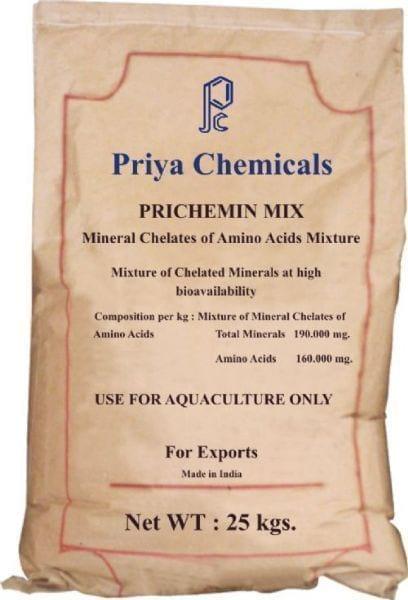Check out what is new in Aquaculture
Find the best technical articles, forums, and videos on Aquaculture at Engormix. Enter now and interact with the world's largest agricultural social network.
1. Introduction Poultry and fish are both increasing in popularity as protein sources in human diets. Fish consumption has increased by 122% between 1990 and 2018 [1] with an over 500% rise in aquaculture production globally over the same timescale. Salmon production is estimated to reach 2.7 million tonnes (MT) by 2021, compared to 0.8 MT in 2000 [2]. Similarly, poultry meat production is also increasing year on year and is predicted to have reached 137 MT in 2020 [1]. This...
Comments : 0
Recommendations: 0
Aquaculture plays a major role in augmenting food production, livelihood and thereby the economy of a country. Diseases are the outcome of imbalance between environment, host and pathogen. During the past three decades, viral and bacterial diseases have emerged as serious impediments to shrimp farming. Concomitant with the expansion and Intensification of shrimp aquaculture, large number of diseases, especially those caused by viral infection, have been recorded in farmed shrimp. The...
Comments : 1
Recommendations: 1


PRICHEMIN MIX
Priya's PRICHEMIN MIX is a mineral supplement for aquaculture. It consists of a mix of mineral chelats from aminoacids
Suggested link
The efficacy of a single cell protein (SCP) methanotroph (Methylococcus capsulatus, Bath) bacteria meal (FeedKind®, Calysta, Menlo Park, CA, United States), in Pacific white shrimp (Penaeus vannamei) diets was studied to determine growth performance, survival rate and disease resistance against Vibrio parahaemolyticus causing Acute Hepatopancreatic Necrosis Disease (AHPND). The growth trial was assigned in a completely randomized design (CRD) with four treatments and 5 replicates of...
Comments : 0
Recommendations: 1
1 Introduction Due to wastewater production and the manufacture of polymeric materials through different industrial processes, industrial development has posed numerous environmental challenges [1]. Water and land contamination may result from wanton dumping of this waste (with or without adequate treatment) and the polymer. Notwithstanding the heinous negative effects on soil and water [2] this impacts negatively on the wellbeing of living creatures [3]. This has been a major...
Comments : 0
Recommendations: 2


PRICHEMIN MIX
Priya's PRICHEMIN MIX is a mineral supplement for aquaculture. It consists of a mix of mineral chelats from aminoacids
Suggested link
1. Introduction Over the years, water pollution has become one of the major environmental challenges facing most of the states in Southern Nigeria, particularly the Niger Delta region. Niger Delta is one of the most prominent regions in Nigeria with vast aquatic ecosystems greatly blessed with variety of fish species both Fin and Shell fishes [1]. Amongst other states in the region, Rivers and Bayelsa State coastal waters are faced with massive environmental pollutions due to...
Comments : 0
Recommendations: 0
INTRODUCTION Diatoms play a major component and dominant life form of the phytoplankton community. Diatoms are made up of complex silica cell wall and microscopically single-celled autotrophic eukaryotic algae belonging to the class Bacillariophyceae and kingdom Protista 1 . The tiny algae diatom range from 2 and 500µm in length or diameter and their habitation vary from ocean to freshwater systems exhibiting seasonal variations during monsoon...
Comments : 0
Recommendations: 0


PRICHEMIN MIX
Priya's PRICHEMIN MIX is a mineral supplement for aquaculture. It consists of a mix of mineral chelats from aminoacids
Suggested link
INTRODUCTION The macroscopic algae has always been associated with human and animal life for their innumerable beneficial properties and has been used as a source of food, feed, fertilizer, medicine and the availability of economically cheap phytochemicals.[1,2] Seaweeds are also used as raw material for many industrial products like agar, alginates and carrageenan.[3,4,5] Fresh and dry seaweeds especially brown and red macroalgae are extensively consumed by people especially...
Comments : 0
Recommendations: 0
I. INTRODUCTION Vibrios have emerged as a major problem affecting shrimp culture across the world. The Outbreaks and mass mortalities of vibrios in hatcheries and grow out ponds of shrimp have been reported across many regions (Couch 1978; Overstreet 1978; Lightner 1983, 1985, 1988, 1996; Sindermann 1990; Ruangpan and Kitao 1991, 1992; Chen et al. 1992; Yang et al. 1992; de la Pena et al. 1993; Jiravanichpaisal et al. 1994;...
Comments : 1
Recommendations: 0


PRICHEMIN MIX
Priya's PRICHEMIN MIX is a mineral supplement for aquaculture. It consists of a mix of mineral chelats from aminoacids
Suggested link
This study aimed to investigate the prevalence, antibiogram of Pseudomonas aeruginosa (P. aeruginosa), and the distribution of virulence genes (oprL, exoS, phzM, and toxA) and the antibiotic-resistance genes (blaTEM, tetA, and blaCTX-M). A total of 285 fish (165 Oreochromis niloticus and 120 Clarias gariepinus) were collected randomly from private fish farms in Ismailia Governorate, Egypt. The collected specimens were examined bacteriologically. P. aeruginosa was isolated from 90 examined...
Comments : 0
Recommendations: 0
Introduction Shrimp farming is one of the most important aquaculture practices worldwide. In shrimp-farming operations, one of the primary wastes of concern is nitrogen. The built-up of nitrogenous waste in the form of ammonia, nitrite and nitrate from the shrimp continuously degrade the culture environment. Ammonia is excreted by animals and also arises from decomposing organic solids such as uneaten feed. The excess feed and fecal matter deposited in the bottom of the pond...
Comments : 1
Recommendations: 2


PRICHEMIN MIX
Priya's PRICHEMIN MIX is a mineral supplement for aquaculture. It consists of a mix of mineral chelats from aminoacids
Suggested link
...
Comments : 5
Recommendations: 3
1. Introduction In Nigeria today, despite the significant investment in commercial agriculture by the government, aid agencies, multilateral organizations and individuals, livestock production has not succeeded in meeting the protein demands in the country (Oluwatayo and Adedeji, 2019) [1]. The increasing human population in the country has indicated that the conventional forms of livestock production and artisanal fisheries which have been over-exploited will not be sufficient...
Comments : 5
Recommendations: 4


PRICHEMIN MIX
Priya's PRICHEMIN MIX is a mineral supplement for aquaculture. It consists of a mix of mineral chelats from aminoacids
Suggested link
INTRODUCTION Among the essential amino acids (AA), L-arginine (ARG) is one of the functional amino acids in animals. ARG is a nutritionally very important and essential AA for fish, and is considered the fourth limiting AA in aquafeed. Most of fish species excretes ammonia predominantly through the gills, diffusing NH 3 or NH 4 (ammoniotelic animals). Therefore, unlike mammals, fish have a low hepatic activity of carbamoyl phosphate synthase III or ornithine carbamoyl...
Comments : 0
Recommendations: 1
Introduction Silver has long been known to exhibit a strong toxic activity towards a wide range of microorganisms, for this reason silver based compounds have been extensively used in many bactericidal applications. Nano particles due to their large surface area are highly reactive and Ag Nano particles have been tested in various fields of biological sciences, Viz drug delivery, wound treatment, binding with HIV gp120 protein , in water treatment and as antibacterial compound...
Comments : 0
Recommendations: 0


PRICHEMIN MIX
Priya's PRICHEMIN MIX is a mineral supplement for aquaculture. It consists of a mix of mineral chelats from aminoacids
Suggested link
Introduction The fish nutrition has advanced with the expansion of aquaculture in order to achieve better performance rates. Thus, diets should provide all the nutrients and energy as a way to optimize the fish development. Among the nutrients, the fatty acids are essential for growth and survival, as well one of the most important sources of energy. The fatty acids of the omega 3 family are not produced by the fish, requiring supplementation in...
Comments : 1
Recommendations: 0
1. INTRODUCTION Histidine (Hist) is one of the 10 essential amino acids for fish, and its importance in nutrition expanding the role of this amino acid beyond its function in protein synthesis. It is well recognized that histidine deficiency can impair growth as well as feed conversion in fish (1, 2). Its metabolites, such as carnosine, anserine and NAH (N-acetyl histidine) play an important role in antioxidant capacity, recovery from fatigue and regulation of osmotic pressure...
Comments : 0
Recommendations: 0


PRICHEMIN MIX
Priya's PRICHEMIN MIX is a mineral supplement for aquaculture. It consists of a mix of mineral chelats from aminoacids
Suggested link
I. INTRODUCTION Nile Tilapia (Oreochromis niloticus) is one of the most commonly cultured freshwater fish species in Nigeria. It is a prolific breeder, widely farmed across the nations of the earth and the third largest cultured finfish [1]. Oreochromis niloticus is a native of Africa [2], considered as a standout farmed fish because of its high nutritional qualities, fast growth rate, resistance to diseases and its ability to withstand sudden environmental changes [3]. In spite...
Comments : 0
Recommendations: 1
INTRODUCTION Seaweeds are the raw material for many industrial products like agar, alginates and carrageenan; also, they continue to be widely consumed as food and medicine in Asian countries.[1,2,3] Most edible seaweeds are known to contain significant quantities of protein, lipids, minerals, vitamins[4,5,6,7] , and nutrient contents.[8,9] Seaweeds are also considered as a source of bioactive compounds and antioxidants as they...
Comments : 0
Recommendations: 0


PRICHEMIN MIX
Priya's PRICHEMIN MIX is a mineral supplement for aquaculture. It consists of a mix of mineral chelats from aminoacids
Suggested link
INTRODUCTION The acute hepatopancreatic necrosis disease (AHPND) has affected shrimp farming in several countries, like, Vietnam, Malaysia, Thailand, Mexico and in Philipines.1-6 The unique symptoms and characteristics of this disease consisting of massive sloughing of hepatopancreas epithelial cells. The external symptoms in infected shrimp like, empty stomach, bluish body color and shrunken hepatopancreas could be observed. The rate of mortaly is significantly higher...
Comments : 2
Recommendations: 0
Introduction Hematological parameters of fish blood are useful tools that aid in the study immuno-potentiators. Such tests are general but not conclusive and must be correlated with biochemical tests of the subject. The classification of leucocytes as in the vertebrates has been done following morphological criteria where by various groups can be distinguished such as lymphocytes, granulocytes and macrophages (Ellis, 1981). Dominguez et al. (2004) confirmed that elevating...
Comments : 0
Recommendations: 1














